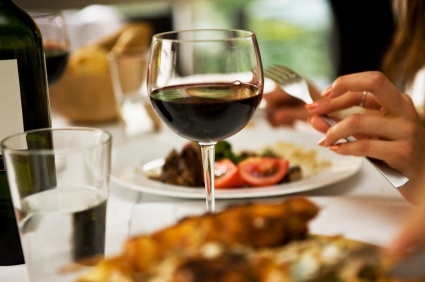
No true lover of wine would content herself by drinking wine alone without food or company. She understands that in the calculus of pleasures, the whole exceeds the sum of its parts. In this case, food + wine is a case of 1 + 1 = 11, not 2. Pairing them together make both the drink and the meal exponentially more delicious.
A History of Traditional Pairings and Some Unconventional Partnerships
Some marriages of food and wine are classic and time-tested, others are idiosyncratic, but either way you will know a great experience when you have one. For a classic, try a Sauternes with a blue cheese, preferably Roquefort. The blessings of culture: you could have drunk for a lifetime without discovering that one on your own. As an example of the idiosyncratic, one of my personal favorite discoveries is Champagne and pizza. All types of pizza. I love it. In the spirit of improbable unions that somehow work wonderfully, let’s consider the two most basic rules of food-and-wine pairing. Rule One: Drink red wine with meat and white wine with fish and poultry. Rule Two: Forget Rule One. Gastronomic norms are helpful, but they are only derivations of experience, not prescriptions. Nothing can trump the “wow” moment you experience for yourself.
Of course, wine is a limited resource and not cheap. It is indeed possible to choose wrong, or at least to make one choice far worse than another. The French don’t believe that all pairings are valid any more than they believe all children are bright. Quality is about degrees of difference. So what follows is not a set of prescriptions but, I hope, a framework allowing you to operate according to individual taste while avoiding common pitfalls. Life’s too short for a Shiraz-and poached-Dover-sole experiment (though it beats any Coca-Cola pairing). For professionals, food-and-wine pairings can get insanely complicated—accounting for grape, region, vintage and style in relation to each single food item. Then a change of sauce and all bets are off. As in all things, I seek pleasure in simplicity.
The simplest plan is to drink one wine throughout the meal. Select one that goes best with the main course and is at least not wildly at odds with any of the others. (At a restaurant, I recommend you choose your main course, then settle on the wine, then decide on your starter—that is, pair the wine to food and then pair the remaining food selections to the wine.) As I write this, I am in Beverly Hills, and last evening I dined at Spago and drank a full-bodied Champagne throughout the meal; it was superb with the duck main course and a fine complement to the fish appetizer. For multi-wine, multi-course dinners, a good rule of thumb is to proceed from light to full-bodied wines, and/or from young to old. So that perhaps means a white wine, then a red (white after red is actually extremely rare and usually comes up because of a cheese or dessert choice). So you might see: Champagne (peerless apéritif), white wine, red wine. Or perhaps, under even fancier circumstances, Champagne, white wine, young red wine, old red wine, dessert wine.
The notion of holding back the older wines upends a rule at least as old as the New Testament. At the marriage at Cana, the best wines were expected to be served first, before the guests got sloshed and could not appreciate them. And so there was general surprise when the wine Jesus made from water was served late in the meal and proved to be better than the wine served earlier. Nowadays we know that pleasures should build as a meal progresses—no anticlimaxes. And drinking too much too soon negates pleasure, though don’t hold back your best wine or wine-and-food pairing till your palate is fatigued.
Next: Learn how to pair wine with appetizers and main courses.
